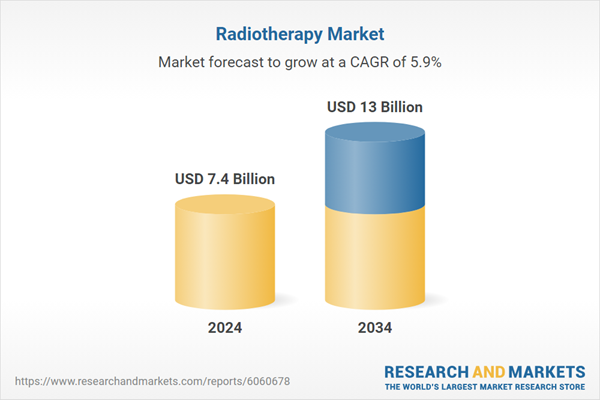The market growth is primarily driven by increased public awareness about various cancer treatment options, including radiotherapy. Numerous government and non-profit organizations run awareness campaigns to educate the public on the importance of early cancer detection and treatment options. Additionally, technological advancements such as intensity-modulated radiation therapy (IMRT), image-guided radiation therapy (IGRT), and proton therapy are significantly improving the precision of radiotherapy, allowing for the targeting of cancerous cells while sparing healthy tissues. These innovations are making radiotherapy an increasingly preferred treatment option for cancer patients.
The external beam radiation therapy segment generated USD 4.8 billion in 2024 and is expected to continue its growth at a CAGR of 5.9% through 2034. This growth is mainly attributed to the rising incidence of various types of localized cancers, including breast, prostate, lung, and colon cancers. The increasing adoption of advanced proton therapy, a form of external beam radiotherapy, contributes to the segment's expansion.
The hospital segment generated USD 3.1 billion in 2024 due to the availability of advanced radiotherapy technologies such as linear accelerators and proton therapy systems. Hospitals serve as comprehensive centers for cancer treatment, offering various therapies like chemotherapy, immunotherapy, and surgeries. The collaboration between hospitals and manufacturers to develop and implement cutting-edge radiotherapy equipment has further fueled the segment's growth.
U.S. Radiotherapy Market generated USD 2.5 billion in 2024 driven by the rising cancer incidence across the country. As the number of cancer diagnoses continues to increase, there is a growing demand for advanced treatment options, with radiotherapy being one of the most effective and widely used methods. The increasing awareness of radiotherapy’s effectiveness, along with its role in both curative and palliative treatments, has further contributed to its adoption.
Prominent players in the Radiotherapy Market include Mevion Medical Systems, Accuray, Toshiba Energy Systems and Solutions, Brainlab, Mitsubishi Electric, IBA Radiopharma Solutions, Isoray Inc., Hitachi High-Tech, RefleXion, Curium, Elekta, Canon Medical Systems, Nordion, NTP Radioisotopes, Varian Medical Systems. To strengthen their market position, companies operating in the radiotherapy industry are focusing on expanding their product portfolios and improving the technological capabilities of their equipment. Many market players are investing in developing innovative radiotherapy systems that integrate advanced features such as precision imaging, real-time guidance, and proton therapy capabilities. Collaborations between manufacturers and healthcare facilities are rising to improve the accessibility of state-of-the-art technologies in treatment centers.
Comprehensive Market Analysis and Forecast
- Industry trends, key growth drivers, challenges, future opportunities, and regulatory landscape
- Competitive landscape with Porter’s Five Forces and PESTEL analysis
- Market size, segmentation, and regional forecasts
- In-depth company profiles, business strategies, financial insights, and SWOT analysis
This product will be delivered within 2-4 business days.
Table of Contents
Companies Mentioned
The companies featured in this Radiotherapy market report include:- Accuray
- Brainlab
- Curium
- Canon Medical Systems
- Elekta
- Hitachi High-Tech
- IBA Radiopharma Solutions
- Isoray Inc.
- Mevion Medical Systems
- Mitsubishi Electric
- Nordion
- NTP Radioisotopes
- RefleXion
- Toshiba Energy Systems and Solutions
- Varian Medical Systems
Table Information
| Report Attribute | Details |
|---|---|
| No. of Pages | 139 |
| Published | May 2025 |
| Forecast Period | 2024 - 2034 |
| Estimated Market Value ( USD | $ 7.4 Billion |
| Forecasted Market Value ( USD | $ 13 Billion |
| Compound Annual Growth Rate | 5.9% |
| Regions Covered | Global |
| No. of Companies Mentioned | 16 |









